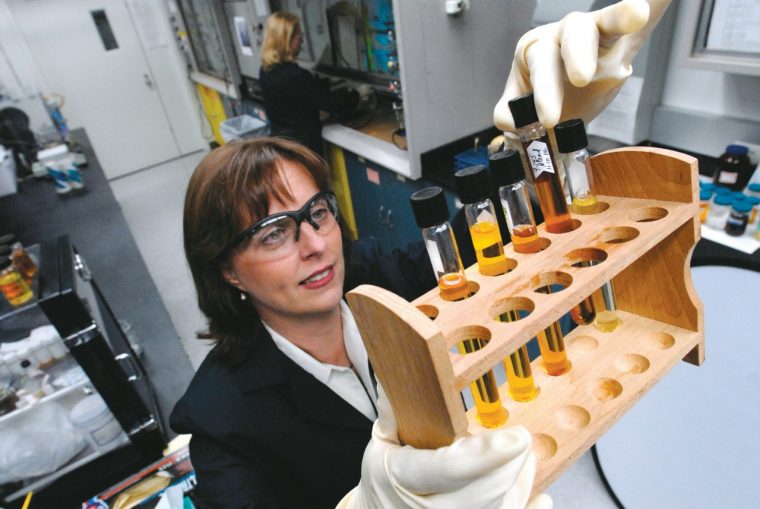Ford Technical Leader of Materials Sustainability Mielewski Looks Back on a Decade of Soy Foam

Ford Technical Leader of Plastics Research Debbie Mielewski observes a polyol separation in the laboratory
You may or may not be aware that Ford uses a soybean-based foam in its vehicles’ seat cushions, seat backs, and headrests, but it’s a common practice that began a full 10 years ago with the launch of the 2008 Mustang before becoming a standard for every North American-built Ford in 2011.
The results of this innovation are pretty astounding when weighed together. Debbie Mielewski, Senior Technical Leader, Materials Sustainability, Ford Motor Company, wrote about the use of soy foam in a blog at Medium, wherein she broke down the numbers: more than 18.5 million Fords have been built using the soybean foam, which has required trillions of soybeans to manufacture.
As a result of this more sustainable material, Ford has prevented somewhere north of 228 million pounds of carbon dioxide from being expelled into the atmosphere. Per North Carolina State University, that’s the same amount of CO2 that would be consumed by approximately 4 million trees per year.
As Mielewski writes, perfecting the product has been something of a challenge, though one well worth undertaking given the result.
“Those first foams, frankly, were terrible! They met none of the rigorous requirements of automotive seating,” she writes. “Early trials failed to meet durability standards for seat cushions, which need to rebound for the equivalent of 15 years. Not to mention, the soy and petroleum materials separated, and the soy foam didn’t smell very good. So we set out to painstakingly explore how to improve the formulations, rebalance the chemistries, and remove odorous compounds.”
But Ford ultimately achieved success in developing its soy foam and brought it to market in 2008 with the Mustang. When that step proved successful, it was implemented in every Ford vehicle. This also led developers to think of more ways to introduce sustainable materials into Ford products.
“Of course, our work implementing biomaterials into our vehicles has not been accomplished overnight. We are proud to now feature eight sustainable materials in our production vehicles—soy, wheat, rice, castor, kenaf (hibiscus), tree cellulose, jute, and coconut. As we continue to experiment, the list of renewable resources we are researching reads like an entire farm—wheat straw, tomato peel, bamboo, agave fiber, dandelions, even algae!”
To get Mielewski’s history of Ford’s soy foam innovation, and where she feels Ford’s sustainable future lies, read her piece over at Medium.com.

The News Wheel is a digital auto magazine providing readers with a fresh perspective on the latest car news. We’re located in the heart of America (Dayton, Ohio) and our goal is to deliver an entertaining and informative perspective on what’s trending in the automotive world. See more articles from The News Wheel.

